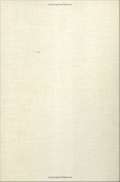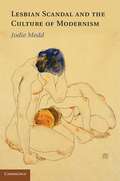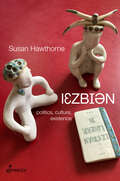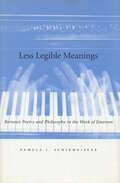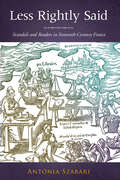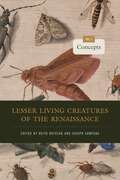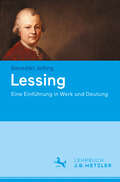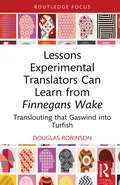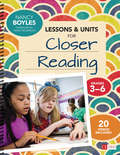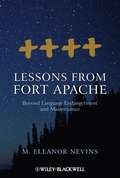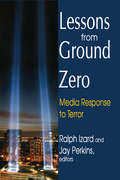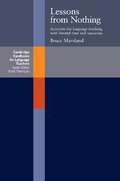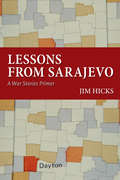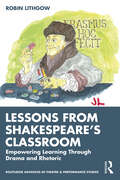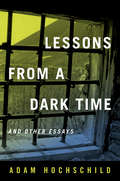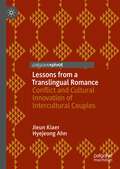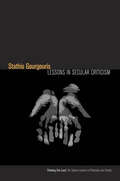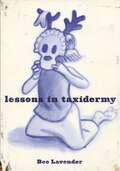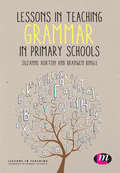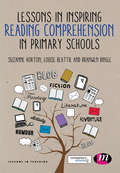- Table View
- List View
Lesbian Rule: Cultural Criticism and the Value of Desire
by Amy VillarejoWith hair slicked back and shirt collar framing her young patrician face, Katherine Hepburn's image in the 1935 film Sylvia Scarlett was seen by many as a lesbian representation. Yet, Amy Villarejo argues, there is no final ground upon which to explain why that image of Hepburn signifies lesbian or why such a cross-dressing Hollywood fantasy edges into collective consciousness as a lesbian narrative. Investigating what allows viewers to perceive an image or narrative as "lesbian," Villarejo presents a theoretical exploration of lesbian visibility. Focusing on images of lesbians in film, she analyzes what these representations contain and their limits. She combines Marxist theories of value with poststructuralist insights to argue that lesbian visibility operates simultaneously as an achievement and a ruse, a possibility for building a new visual politics and away of rendering static and contained what lesbian might mean. Integrating cinema studies, queer and feminist theory, and cultural studies, Villarejo illuminates the contexts within which the lesbian is rendered visible. Toward that end, she analyzes key portrayals of lesbians in public culture, particularly in documentary film. She considers a range of films--from documentaries about Cuba and lesbian pulp fiction to Exile Shanghai and The Brandon Teena Story--and, in doing so, brings to light a nuanced economy of value and desire.
Lesbian Scandal and the Culture of Modernism
by Jodie MeddBefore lesbianism became a specific identity category in the West, its mere suggestion functioned as a powerful source of scandal in early twentieth-century British and Anglo-American culture. Reconsidering notions of the 'invisible' or 'apparitional' lesbian, Jodie Medd argues that lesbianism's representational instability, and the scandals it generated, rendered it an influential force within modern politics, law, art and the literature of modernist writers like James Joyce, Ezra Pound and Virginia Woolf. Medd's analysis draws on legal proceedings and parliamentary debates as well as crises within modern literary production - patronage relations, literary obscenity and cultural authority - to reveal how lesbian suggestion forced modern political, cultural and literary institutions to negotiate their own identities, ideals and limits. Medd's text will be of great interest to scholars and graduate students in gender and women's studies, modernist literary studies and English literature.
Lesbian: Politics, Culture, Existence
by Susan HawthorneAcross almost 50 years of writing, Susan Hawthorne' s essays on lesbian culture and politics take the reader on a journey through the concerns of radical feminists engaged in the Women' s Liberation Movement. Not only does she trace the experiments of lesbians creating a vibrant woman-loving culture, but she also traces the backlash against lesbians and a history of violence perpetrated by the state, corporations and individual men. She begins with a recollection of a rape in her pre-feminist days, followed by a critique of the institution of heterosexuality and the role of lesbian feminism as a strategy. She is soon asking questions about lesbian existence. The essays span reflections on lesbian literature and the development of lesbian culture, including the politics of physical expression in circus. Susan Hawthorne writes about cultural appropriation, depoliticization and the erasure of lesbian inventiveness. She researches violence against lesbians including rape, torture and murder and the way in which this violence is ignored and often distorted by the media. Her investigations include lesbian refugees, lesbian economics, violation of lesbian human rights and the impact of the transgender industrial complex on the existence of lesbians as a political force.
Lesbianism in Swedish Literature: An Ambiguous Affair
by Jenny BjörklundHere, Björklund shows that Swedish literary discourses on lesbianism provocatively contrast with a widely accepted view that attitudes toward homosexuality have gradually become more tolerant. The lasting power of negative discourses upends the assumption that Sweden's progressive laws reflect progressive attitudes toward homosexuality.
Less Legible Meanings: Between Poetry and Philosophy in the Work of Emerson
by Pamela J. SchirmeisterExamining both why and how Emerson evades the ancient quarrel between literature and philosophy, this book entirely rethinks the nature of Emerson's radical individualism and its relation to the possibility of an ethics and a politics. The author argues that the quarrel between literature and philosophy never took place in America, and that instead traditional philosophical work staged itself here as a form of literary praxis and cultural therapeutics. Epitomized in the work of Emerson, this praxis takes shape explicitly in Emerson's understanding of democracy and occurs as an exchange within the act of reading. This is the exchange that Emerson so eloquently calls for in "The American Scholar" under the name of "letters." Emerson's project for American letters is the creation of a new national identity; as Less Legible Meanings makes clear, we have not yet understood the full range of implications that this project entails. After situating American letters in relation to German and British Romanticism and the features of American culture that augmented and altered their reception in the United States, the book goes on to explore the type of reading that Emersonian rhetoric engenders. Both persuasive and tropological, this rhetoric elicits from the reader something similar to psychoanalytic transference. Its goal is to lead the reader to a point at which representational logic breaks down so that a new subject can take shape. The purpose of such rhetoric, however, extends well beyond personal self-creation, because the construction of the subject emerges as the very possibility of the passage from the private sphere to the public one. In this passage, our entire notion of liberal individualism must be rethought, and with it, the pragmatic question of Emersonian ethics and politics. A revisionary study of some of Emerson's central essays, Less Legible Meanings also invites the reader to reconsider the nature of Emerson's influence on contemporary American culture and to discover new ways in which we might continue to understand his work. Interdisciplinary in scope, the book makes equal use of the history of philosophy, psychoanalytic theory, and cultural history.
Less Rightly Said
by Antonia SzabariWell-known scholars and poets living in sixteenth-century France, including Erasmus, Ronsard, Calvin, and Rabelais, promoted elite satire that "corrected vices" but "spared the person"--yet this period, torn apart by religious differences, also saw the rise of a much cruder, personal satire that aimed at converting readers to its ideological, religious, and, increasingly, political ideas. By focusing on popular pamphlets along with more canonical works, Less Rightly Said shows that the satirists did not simply renounce the moral ideal of elite, humanist scholarship but rather transmitted and manipulated that scholarship according to their ideological needs. Szabari identifies the emergence of a political genre that provides us with a more thorough understanding of the culture of printing and reading, of the political function of invectives, and of the general role of dissensus in early modern French society.
Lesser Living Creatures of the Renaissance: Volume 1, Insects (Animalibus)
by Keith Botelho and Joseph CampanaLesser Living Creatures examines literary and cultural texts from early modern England in order to understand how people in that era thought about—and with—insect and arachnid life. Designed for the classroom, the book comprises two volumes—Insects and Concepts—that can be used together or independently. Each addresses the collaborative, multigenerational research that produced early modern natural history and provides new insights into the old question of what it means to be human in a world populated by beasts large and small.Volume 1, Insects, examines how insects burrowed into the literal and symbolic economies of the era. The contributors consider diminutive creatures—such as bees and beetles, flies and fleas, silkworms and spiders—and their depictions in plays, poetry, fables, natural histories, and more. In doing so, they illuminate how early modern science and literature worked as intersecting systems of knowledge production about the natural world and show definitively how insect life was, and remains, intimately entangled with human life.In addition to the editors, contributors to this volume include Chris Barrett, Roya Biggie, Bruce Boehrer, Gary Bouchard, Dan Brayton, Eric Brown, Mary Baine Campbell, Perry Guevara, Shannon Kelley, Emily King, Karen Raber, Kathryn Vomero Santos, Donovan Sherman, and Steven Swarbrick.
Lesser Living Creatures of the Renaissance: Volume 2, Concepts (Animalibus)
by Keith Botelho and Joseph CampanaLesser Living Creatures examines literary and cultural texts from early modern England in order to understand how people in that era thought about—and with—insect and arachnid life. The conversations in this two-volume set address the collaborative, multigenerational research that produced early modern natural history and provide new insights into the old question of what it means to be human in a world populated by beasts large and small.Volume 2, Concepts, explores ideas that cut across species, insect and otherwise, both building on and invigorating critical vocabularies developed over nearly two decades of early modern animal studies. The contributors explore topics such as the medical and culinary consumption of insects; extermination campaigns; the auditory and emotive effects of a swarm; insects and politics; and notions of infestation, stinging, and creeping. Throughout, they illuminate how early modern science and literature worked as intersecting systems of knowledge production about the natural world and show definitively how insect life was, and remains, intimately entangled with human life.In addition to the editors, contributors to this volume include Lucinda Cole, Frances E. Dolan, Lowell Duckert, Andrew Fleck, Rebecca Laroche, Jennifer Munroe, Amy L. Tigner, Jessica Lynn Wolfe, Derek Woods, and Julian Yates.
Lessing: Eine Einführung in Werk und Deutung
by Benedikt JeßingGotthold Ephraim Lessing ist neben Schiller und Goethe der meistgelesene und -unterrichtete deutsche Dichter des 18. Jahrhunderts. Sein Werk, das v.a. mit dem Begriff des bürgerlichen Trauerspiels und dem Nathan verbunden ist, umfasst daneben Lustspiele, Fabeln und Lyrik und gilt als Höhepunkt der literarischen Aufklärung. Mindestens ebenso wichtig zum Verständnis seiner Schriften ist die Tradition der Empfindsamkeit, die er in seinen theoretischen Arbeiten und literarischen Werken fortführt. Der Band erschließt auf Basis einer knappen Erörterung der theoretischen Positionen die wichtigsten Werke Lessings in textnahen Lektüren.
Lesson and Unit Assessment Grade K Book 2
by McGraw-Hill EducationLessons in writing, grammar, and mechanics provide students a reference book to learn about and check critical writing, revising, and editing skills. The Language Arts Handbook is an integral part of the writing lessons.
Lessons Experimental Translators Can Learn from Finnegans Wake: Translouting that Gaswind into Turfish (Routledge Advances in Translation and Interpreting Studies)
by Douglas RobinsonInspiring translators by making specific experimental writing strategies available to them, this book reimagines experimental translation through close readings of Finnegans Wake.Robinson’s engagement with translational aspects of Finnegans Wake provides rich and useful insights into experimental translation that encourage new approaches to translation theory and practice. The author analyses Joyce’s serial homophonic translations, portmanteau words, and heteronyms along translational lines (following Fritz Senn, Clive Hart, Patrick O’Neill, and others), and offers a showcase translation of Walter Benjamin’s “Task of the Translator” using all three experimental techniques borrowed from the Wake.The book will be a valuable addition to any postgraduate course in translation theory, literary theory, and Joycean literature. Translation scholars, students, and researchers will find this text a compelling read.
Lessons and Units for Closer Reading, Grades 3-6: Ready-to-Go Resources and Planning Tools Galore (Corwin Literacy Ser.)
by Nancy BoylesReady-to-go units to ramp up close reading Want a yearlong close reading curriculum to insert in your literacy block? You’ve got it. Nancy Boyles’ Lessons & Units for Closer Reading features 32 lessons, based on readily available complex picture books and organized by eight learning pathways for approaching literature and information. Get started right away, with the help of: Short nonfiction articles to kick off each unit Assessment tasks, rubrics, planning templates, and more Links to 20+ instructional video segments Page-by-page text-dependent questions for every book With Closer Reading, Nancy expertly delivered answers to the why and how of close reading. Now, with this phenomenal sequel, you’re treated to her playbook.
Lessons and Units for Closer Reading, Grades 3-6: Ready-to-Go Resources and Planning Tools Galore (Corwin Literacy Ser.)
by Nancy BoylesReady-to-go units to ramp up close reading Want a yearlong close reading curriculum to insert in your literacy block? You’ve got it. Nancy Boyles’ Lessons & Units for Closer Reading features 32 lessons, based on readily available complex picture books and organized by eight learning pathways for approaching literature and information. Get started right away, with the help of: Short nonfiction articles to kick off each unit Assessment tasks, rubrics, planning templates, and more Links to 20+ instructional video segments Page-by-page text-dependent questions for every book With Closer Reading, Nancy expertly delivered answers to the why and how of close reading. Now, with this phenomenal sequel, you’re treated to her playbook.
Lessons from Fort Apache: Beyond Language Endangerment and Maintenance (Wiley Blackwell Studies in Discourse and Culture #4)
by M. Eleanor NevinsThis incisive ethnographic analysis of indigenous language documentation, maintenance, and revitalization focuses on linguistic heritage issues on the Native American reservation at Fort Apache and explores the broader social, political and religious influences on changing language practices in indigenous communities. Offers a focused ethnographic analysis of an indigenous community that also explores global issues of language endangerment and maintenance and their socio-historical contexts Addresses the complexities and conflicts in language documentation and revitalization programs, and how they articulate with localized discourse genres, education practices, religious beliefs, and politics Examines differing evaluations of language loss, and maintenance, among members of affected communities, and their creative responses to challenges posed by encompassing socio-cultural regimes, including university accredited language experts Provides an ethnographic analysis of speech in indigenous communities that moves beyond narrowly conceived language documentation to consider changing linguistic and social identities
Lessons from Ground Zero: Media Response to Terror
by Jay PerkinsIt ranked among journalism's finest hours. That is what was heard in the weeks following September 11, 2001. They made mistakes, of course, but in covering one of the biggest disasters ever to hit the United States, journalists used their training, their experience, their understanding, and their sensitivity to provide coverage that helped bring understanding and a sense of calm to the chaos. Their performance did not end with reporting the immediate impact of the catastrophe. They continued to analyze what happened, the impact to property and human lives, the impact on government and foreign relations. Lessons from Ground Zero's examines journalism's efforts to cover a crisis, while analyzing journalism itself. Many lessons were evident to journalists as they sought to cope with the challenges of covering 9/11. The long-term question, however, is whether the answers they found served as catalysts for better journalism in the future, or whether they have been forgotten, put into the closet of old memories with no noticeable long-term impact. This book analyzes journalists' response to 9/11 through scholarly research and interviews with many of the journalists who covered 9/11. Sometimes they do not agree, but all are thoughtful and each adds to understanding. Public opinion polls show clearly that citizens appreciated and responded to media coverage. Given that this occurred in a time frame in which public approval of American journalism had declined, it is reasonable to ask what the media did that was different from their normal practices. This book provides some of the answers.
Lessons from Nothing
by Penny Ur Bruce MarslandLessons from Nothing is an invaluable resource for busy teachers everywhere who are looking for easy-to-use activities which do not require extensive facilities or preparation. It is a practical source of around 70 language teaching activities which encourage interaction and co-operation in the classroom. Special features: * activities for immediate use * activities for all ages and levels * clear presentation * no photocopying required.
Lessons from Sarajevo: A War Stories Primer
by Jim HicksIn today's world, our television screens are filled with scenes from countless conflicts across the globe--commanding our attention and asking us to choose sides. In this insightful and wide-ranging book, Jim Hicks treats historical representation, and even history itself, as a text, asking questions such as Who is speaking?, Who is the audience?, and What are the rules for this kind of talk? He argues that we must understand how war stories are told in order to arm ourselves against them. In a democracy, we are each responsible for policy decisions taken on our behalf. So it is imperative that we gain fluency in the diverse forms of representation (journalism, photography, fiction, memoir, comics, cinema) that bring war to us. Hicks explores the limitations of the sentimental tradition in war representation and asks how the work of artists and writers can help us to move beyond the constraints of that tradition. Ranging from Walt Whitman's writings on the Civil War to the U.S. wars in Iraq and Afghanistan, and focusing on the innovative and creative artistic expressions arising out of the wars of the former Yugoslavia, Hicks examines how war has been perceived, described, and interpreted. He analyzes the limitations on knowledge caused by perspective and narrative position and looks closely at the distinct yet overlapping roles of victims, observers, and aggressors. In the end, he concludes, war stories today should be valued according to the extent they make it impossible for us to see these positions as assigned in advance, and immutable.
Lessons from Shakespeare’s Classroom: Empowering Learning Through Drama and Rhetoric (Routledge Advances in Theatre & Performance Studies)
by Robin LithgowThis volume explores the relationship between the emphasis on performance in Elizabethan humanist education and the flourishing of literary brilliance around the turn of the sixteenth century. This study asks us what lessons we can learn today from Shakespeare’s Latin grammar school. What were the cognitive benefits of an education so deeply rooted in what Demosthenes and Quintilian called "actio"—acting? Because of the vast difference between educational practice then and now, we have not often followed one essential thread: the focus on performance. This study examines the connections relevant to the education offered in schools today. This book will be of great interest to teachers, scholars, and administrators in performing arts and education.
Lessons from a Dark Time and Other Essays
by Adam HochschildIn this rich collection, bestselling author Adam Hochschild has selected and updated over two dozen essays and pieces of reporting from his long career. Threaded through them all is his concern for social justice and the people who have fought for it. The articles here range from a California gun show to a Finnish prison, from a Congolese center for rape victims to the ruins of gulag camps in the Soviet Arctic, from a stroll through construction sites with an ecologically pioneering architect in India to a day on the campaign trail with Nelson Mandela. Hochschild also talks about the writers he loves, from Mark Twain to John McPhee, and explores such far-reaching topics as why so much history is badly written, what bookshelves tell us about their owners, and his front-row seat for the shocking revelation in the 1960s that the CIA had been secretly controlling dozens of supposedly independent organizations. With the skills of a journalist, the knowledge of a historian, and the heart of an activist, Hochschild shares the stories of people who took a stand against despotism, spoke out against unjust wars and government surveillance, and dared to dream of a better and more just world.
Lessons from a Translingual Romance: Conflict and Cultural Innovation of Intercultural Couples
by Jieun Kiaer Hyejeong AhnIntercultural couples (ICs) often face unique challenges that go unnoticed. This book delves into the experiences of 20 ICs living in Singapore and explores the complexity of their experiences through the lens of translanguaging. It shows how ICs mix language and culture in a borderless manner, not only between spouses but also with their wider families. Additionally, the authors examine the significance of technological advancements, which have transformed ICs' experiences over the past decade. In particular, parents-in-law pose a significant challenge for Asian-Western couples, as the relationship with them in Asia differs from that in the West. Each couple's unique shared culture and language transcends the borders of nation-states, requiring exchange, sharing, negotiation, and adaptation. This book provides an easy-to-read, holistic exploration of the issues faced by ICs, offering insight into overlooked aspects such as location, in-laws, and technology.
Lessons from the Past: The Moral Use of History in Fourth-Century Prose
by Frances PownallBecause of the didactic nature of the historical genre, many scholars ancient and modern have seen connections between history and rhetoric. So far, discussion has centered on fifth-century authors -- Herodotus and Thucydides, along with the sophists and early philosophers. Pownall extends the focus of this discussion into an important period. By focusing on key intellectuals and historians of the fourth century (Plato and the major historians -- Xenophon, Ephorus, and Theopompus), she examines how these prose writers created an aristocratic version of the past as an alternative to the democratic version of the oratorical tradition. Frances Pownall is Professor of History and Classics, University of Alberta.
Lessons in Secular Criticism (Thinking Out Loud)
by Stathis GourgourisSecular criticism is a term invented by Edward Said to denote not a theory but a practice that counters the tendency of much modern thinking to reach for a transcendentalist comfort zone, the very space philosophy wrested away from religion in the name of modernity. Using this notion as a compass, this book reconfigures recent secularism debates on an entirely different basis, by showing (1) how the secular imagination is closely linked to society’s radical poiesis, its capacity to imagine and create unprecedented forms of worldly existence; and (2) how the space of the secular animates the desire for a radical democratic politics that overturns inherited modes of subjugation, whether religious or secularist.Gourgouris’s point is to disrupt the co-dependent relation between the religious and the secular—hence, his rejection of fashionable languages of postsecularism—in order to engage in a double critique of heteronomous politics of all kinds. For him, secular criticism is a form of political being: critical, antifoundational, disobedient, anarchic, yet not negative for negation’s sake but creative of new forms of collective reflection, interrogation, and action that alter not only the current terrain of dominant politics but also the very self-conceptualization of what it means to be human.Written in a free and combative style and given both to close readings of texts and to gazing off into the broad horizon, these essays cover a range of issues—historical and philosophical, archaic and contemporary, literary and political—that ultimately converge in the significance of contemporary radical politics: the assembly movements we have seen in various parts of the world in recent years. The secular imagination demands a radical pedagogy and unlearning a great many established thought patterns. Its most important dimension is not battling religion per se but dismantling theological politics of sovereignty in favor of radical conditions for social autonomy.
Lessons in Taxidermy: A Compendium Of Safety And Danger (Punk Planet Books #0)
by Bee LavenderA riveting memoir of sickness and survival from Punk Planet Books! “Bee Lavender is a fantastic writer. Her work is deep and personal, and I don’t think there are any places she’s scared to go.” —Michelle Tea, author of The Chelsea Whistle “Bee’s scrupulous, non-histrionic style is thrilling; it allows for some devastating emotional moments because the author comes by them honestly.” —Ayun Halliday, author of No Touch Monkey Diagnosed with cancer at age twelve and perilously pregnant at eighteen, surviving surgeries and violent accidents: sometimes you can't believe Bee Lavender is still alive; sometimes you think nothing could kill her. Lessons in Taxidermy is Lavender's fierce and expressive search for truth and an elusive sense of safety. This autobiographical tale is stark and resolved, but strangely euphoric, tying together moments and memories into a frantic, delicate, and often transcendently funny account of anguish and confusion, pain and poverty, isolation and illusion. While staying conscious of the particulars of her circumstances, Lavender frames her life in the context of history, traveling, landscape, and freak show culture. Lessons in Taxidermy is apocryphal, troubling, cathartic, and important.
Lessons in Teaching Grammar in Primary Schools (Lessons in Teaching)
by Ms Suzanne Horton Ms Branwen BingleAlong with the important subject knowledge, practising and trainee teachers need to know what effective teaching of grammar in primary schools actually looks like. This book provides examples of lessons in teaching primary grammar as a starting point for learning. It explores the theory behind them, how they can be adapted to suit different year groups and different schools, and how you can learn from them to develop your subject and teaching knowledge. This text will help you to teach grammar in an effective and meaningful way and offer support to plan and teach lessons that motivate, engage and inspire pupils to use grammar not only accurately but also creatively to produce writing that is fluid, cohesive and purposeful. This book is part of the Lessons in Teaching series... A series that takes exemplar lesson plans as a starting point for developing subject knowledge and exploring the theory behind them. The lessons can be adapted to suit different year groups and schools. Tried and tested in the classroom Supported by pedagogy and theory In line with the new Primary Curriculum and Teaching Standards The Companion Website accompanying the series includes extra resources to support classroom teaching including, tips, lesson starters, videos and handy Pinterest boards. Visit the companion website at ww.sagepub.co.uk/lessonsinteaching A note from the authors The lesson examples included in this book have all been tried and tested in the classroom and have successfully contributed to children's knowledge and understanding of grammatical concepts. A key feature of these lesson examples is that they build upon children's prior knowledge and their interests. They are not intended to be seen as a 'quick fix' to meet the requirements of English in the National Curriculum. Knowledge about grammar usage should lead to greater understanding of how we can manipulate words and sentences to create particular effects that will touch the heart of the reader. The intention is not to produce a generation of grammar pedants who apply rules and dissect texts in such a way as to destroy its very essence. By teaching grammar within meaningful contexts your lessons will motivate, engage and inspire your pupils to use grammar not only accurately but also creatively to produce writing that is fluid, cohesive and purposeful. We have provided a great deal of background information so that you are able to situate the learning within a contextual framework; however, our ideas and examples can be easily adapted to suit the needs of your learners. The pedagogies associated with the teaching of grammar remain consistent but the suggested games and activities used to consolidate and apply learning are easily transferable. Whilst reading, you may have identified ways in which you can adapt the lessons to teach other aspects of grammar or changed the focus of the learning objective to reflect the demands of your classroom best. In the same way that we expect children to use grammar creatively to address their purpose, we would anticipate that you use the guidance contained in this book to address your purpose.
Lessons in Teaching Reading Comprehension in Primary Schools (Lessons in Teaching)
by Ms Suzanne Horton Ms Branwen Bingle Louise BeattieLesson planning in line with the new Primary National Curriculum! Why do we teach children to read? It is not merely to decode the words. We teach them to derive meaning from the text, to comprehend it. To not just read the lines, but to read between the lines and even read beyond the lines. So how can you make teaching comprehension in primary schools effective and engaging? How are you ensuring that children are finding meaning in what they read and how do we support more able readers to learn more? What does a good 'reading' lesson look like? This book demonstrates the effective teaching of reading through exemplar lessons. It discusses what makes them good lesson plans and how they can be adapted to suit different classes and different schools. In particular, this book helps you to meet the needs of more able readers particularly in years 5 and 6, outlining ways to challenge more able pupils to support them with the level 6 tests in Year 6. It helps you to cultivate your subject knowledge and invigorate your classroom teaching through focusing on what children need to learn and how to teach it. Did you know that this book is part of the Lessons in Teaching series? WHAT IS THE LESSONS IN TEACHING SERIES? Suitable for any teacher at any stage of their career, the books in this series are packed with great ideas for teaching engaging, outstanding lessons in your primary classroom. The Companion Website accompanying the series includes extra resources including tips, lesson starters, videos and Pinterest boards. Visit www.sagepub.co.uk/lessonsinteaching Books in this series: Lessons in Teaching Grammar in Primary Schools, Lessons in Teaching Computing in Primary Schools, Lessons in Teaching Number and Place Value in Primary Schools, Lessons in Teaching Reading Comprehension in Primary Schools, Lesson in Teaching Phonics in Primary Schools
